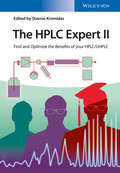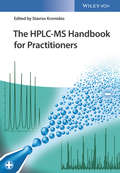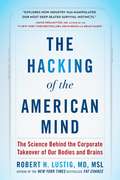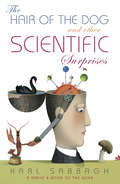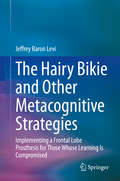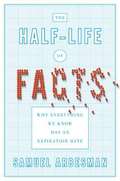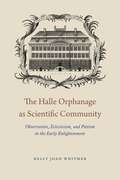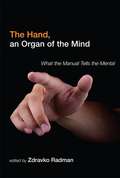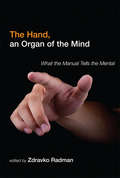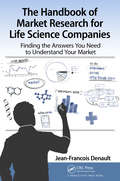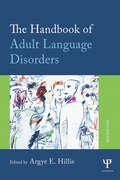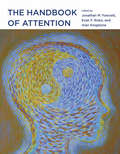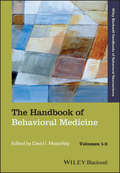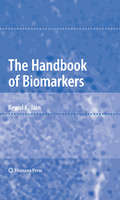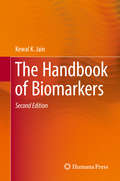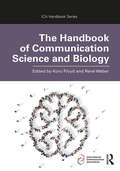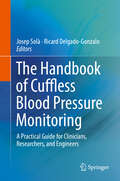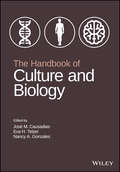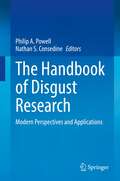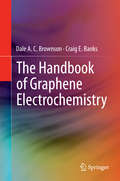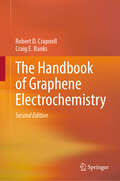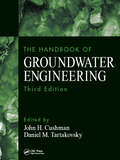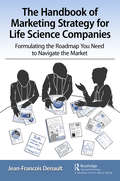- Table View
- List View
The HPLC-Expert II: Optimizing the Benefits of HPLC/UHPLC
by Stavros KromidasHow can I use my HPLC/UHPLC equipment in an optimal way, where are the limitations of the technique? These questions are discussed in detail in the sequel of the successful "HPLC Expert" in twelve chapters written by experts in the respective fields. The topics encompass - complementary to the first volume - typical HPLC users' problems and questions such as gradient optimization and hyphenated techniques (LC-MS). An important key aspect of the book is UHPLC: For which analytical problem is it essential, what should be considered? Besides presentation of latest developments directly from the main manufacturers, also UHPLC users and independent service engineers impart their knowledge. Consistent with the target groups, the level is advanced, but the emphasis is on practical applications.
The HPLC-MS Handbook for Practitioners
by Stavros KromidasFilling the gap for an expert text dealing exclusively with the practical aspects of HPLC-MS coupling, this concise, compact, and clear book provides detailed information to enable users to employ the method most efficiently. Following an overview of the current state of HPLC-MS and its instrumentation, the text goes on to discuss all relevant aspects of method development. A chapter on tips and tricks is followed by user reports on the advantages - and pitfalls - of applying the method in real-life scenarios. The whole is rounded off by a look at future developments by renowned manufacturers.
The Hacking of the American Mind: The Science Behind the Corporate Takeover of Our Bodies and Brains
by Robert H. Lustig"Explores how industry has manipulated our most deep-seated survival instincts."—David Perlmutter, MD, Author, #1 New York Times bestseller, Grain Brain and Brain MakerThe New York Times–bestselling author of Fat Chance reveals the corporate scheme to sell pleasure, driving the international epidemic of addiction, depression, and chronic disease. While researching the toxic and addictive properties of sugar for his New York Times bestseller Fat Chance, Robert Lustig made an alarming discovery—our pursuit of happiness is being subverted by a culture of addiction and depression from which we may never recover. Dopamine is the “reward” neurotransmitter that tells our brains we want more; yet every substance or behavior that releases dopamine in the extreme leads to addiction. Serotonin is the “contentment” neurotransmitter that tells our brains we don’t need any more; yet its deficiency leads to depression. Ideally, both are in optimal supply. Yet dopamine evolved to overwhelm serotonin—because our ancestors were more likely to survive if they were constantly motivated—with the result that constant desire can chemically destroy our ability to feel happiness, while sending us down the slippery slope to addiction. In the last forty years, government legislation and subsidies have promoted ever-available temptation (sugar, drugs, social media, porn) combined with constant stress (work, home, money, Internet), with the end result of an unprecedented epidemic of addiction, anxiety, depression, and chronic disease. And with the advent of neuromarketing, corporate America has successfully imprisoned us in an endless loop of desire and consumption from which there is no obvious escape. With his customary wit and incisiveness, Lustig not only reveals the science that drives these states of mind, he points his finger directly at the corporations that helped create this mess, and the government actors who facilitated it, and he offers solutions we can all use in the pursuit of happiness, even in the face of overwhelming opposition. Always fearless and provocative, Lustig marshals a call to action, with seminal implications for our health, our well-being, and our culture.
The Hadal Zone
by Alan JamiesonThe hadal zone represents one of the last great frontiers in marine science, accounting for 45% of the total ocean depth range. Despite very little research effort since the 1950s, the last ten years has seen a renaissance in hadal exploration, almost certainly as a result of technological advances that have made this otherwise largely inaccessible frontier, a viable subject for research. Providing an overview of the geology involved in trench formation, the hydrography and food supply, this book details all that is currently known about organisms at hadal depths and linkages to the better known abyssal and bathyal depths. New insights on how, where and what really survives and thrives in the deepest biozone are provided, allowing this region to be considered when dealing with sustainability and conservation issues in the marine environment.
The Hair of the Dog: And Other Scientific Surprises
by Karl SabbaghScience is full of surprises: the peculiar peepshow beginnings of baby incubators; the unexpected positive fallout from the H-bomb; the dinosaurs that caused sonic booms; the irrational nature of the number pi; the fifth taste sensation lurking in everyone's taste buds which nobody knew about (except for the Japanese). Whilst shedding light on these conundrums, Karl Sabbagh shows that seemingly trivial queries or assumptions lead to a deeper understanding of how science works. Who would have thought that scientists would turn to the hypothesis 'All swans are white' to determine the stability of the entire universe? Or that if we choose to spend our hard-earned money on other people it might make us happier than if we spend it on ourselves?
The Hair of the Dog: And Other Scientific Surprises
by Karl SabbaghScience is full of surprises: the peculiar peepshow beginnings of baby incubators; the unexpected positive fallout from the H-bomb; the dinosaurs that caused sonic booms; the irrational nature of the number pi; the fifth taste sensation lurking in everyone's taste buds which nobody knew about (except for the Japanese). Whilst shedding light on these conundrums, Karl Sabbagh shows that seemingly trivial queries or assumptions lead to a deeper understanding of how science works. Who would have thought that scientists would turn to the hypothesis 'All swans are white' to determine the stability of the entire universe? Or that if we choose to spend our hard-earned money on other people it might make us happier than if we spend it on ourselves?
The Hairy Bikie and Other Metacognitive Strategies: Implementing a Frontal Lobe Prosthesis for Those Whose Learning Is Compromised
by Jeffrey Baron LeviThe book contains practical and innovative strategies to train clients with Traumatic Brain Injury, Autism, Intellectual Impairment and Behavioural Disorders to compensate for their deficits and to function independently within their environments. The book is a result of 30 years of working directly with clients who are experiencing problems with organization, memory, learning, problem solving and anger management. The book is highly recommended for practitioners working with clients with a range of disability in educational, community or work settings and is a valuable tool to researchers and tertiary institutions to impart this knowledge to future practitioners. The book is highly recommended to be included in a cognitive rehabilitation course for counsellors, neuropsychologists, rehabilitation consultants and vocational rehabilitation consultants. It would be highly relevant for a section in a Special Education course and for school psychologists, special education and mainstream teachers working with children with learning and behavioural disorders.
The Half-Life of Facts: Why Everything We Know Has an Expiration Date
by Samuel ArbesmanNew insights from the science of science Facts change all the time. Smoking has gone from doctor recommended to deadly. We used to think the Earth was the center of the universe and that Pluto was a planet. For decades, we were convinced that the brontosaurus was a real dinosaur. In short, what we know about the world is constantly changing. But it turns out there’s an order to the state of knowledge, an explanation for how we know what we know. Samuel Arbesman is an expert in the field of scientometrics-literally the science of science. Knowledge in most fields evolves systematically and predictably, and this evolution unfolds in a fascinating way that can have a powerful impact on our lives. Doctors with a rough idea of when their knowledge is likely to expire can be better equipped to keep up with the latest research. Companies and governments that understand how long new discoveries take to develop can improve decisions about allocating resources. And by tracing how and when language changes, each of us can better bridge generational gaps in slang and dialect. Just as we know that a chunk of uranium can break down in a measurable amount of time-a radioactive half-life-so too any given field’s change in knowledge can be measured concretely. We can know when facts in aggregate are obsolete, the rate at which new facts are created, and even how facts spread. Arbesman takes us through a wide variety of fields, including those that change quickly, over the course of a few years, or over the span of centuries. He shows that much of what we know consists of "mesofacts”-facts that change at a middle timescale, often over a single human lifetime. Throughout, he offers intriguing examples about the face of knowledge: what English majors can learn from a statistical analysis of The Canterbury Tales, why it’s so hard to measure a mountain, and why so many parents still tell kids to eat their spinach because it’s rich in iron. The Half-life of Facts is a riveting journey into the counterintuitive fabric of knowledge. It can help us find new ways to measure the world while accepting the limits of how much we can know with certainty. .
The Halle Orphanage as Scientific Community: Observation, Eclecticism, and Pietism in the Early Enlightenment
by Kelly Joan WhitmerFounded around 1700 by a group of German Lutherans known as Pietists, the Halle Orphanage became the institutional headquarters of a universal seminar that still stands largely intact today. It was the base of an educational, charitable, and scientific community and consisted of an elite school for the sons of noblemen; schools for the sons of artisans, soldiers, and preachers; a hospital; an apothecary; a bookshop; a botanical garden; and a cabinet of curiosity containing architectural models, "naturalia," and scientific instruments. Yet, its reputation as a Pietist enclave inhabited largely by young people has prevented the organization from being taken seriously as a kind of scientific academy even though, Kelly Joan Whitmer shows, this is precisely what it was. "The Halle Orphanage as Scientific Community" calls into question a long-standing tendency to view German Pietists as anti-science and anti-Enlightenment, arguing that these tendencies have drawn attention away from what was actually going on inside the orphanage. Whitmer shows how the orphanage s identity as a scientific community hinged on its promotion of philosophical eclecticism as a tool for assimilating perspectives and observations and working to perfect one s abilities to observe methodically. Because of the link between eclecticism and observation, Whitmer reveals, those teaching and training in Halle s Orphanage contributed to the transformation of scientific observation and its related activities in this period. "
The Hand, an Organ of the Mind
by Zdravko RadmanCartesian-inspired dualism enforces a theoretical distinction between the motor and the cognitive and locates the mental exclusively in the head. This collection, focusing on the hand, challenges this dichotomy, offering theoretical and empirical perspectives on the interconnectedness and interdependence of the manual and mental. The contributors explore the possibility that the hand, far from being the merely mechanical executor of preconceived mental plans, possesses its own know-how, enabling "enhanded" beings to navigate the natural, social, and cultural world without engaging propositional thought, consciousness, and deliberation. The contributors consider not only broad philosophical questions -- ranging from the nature of embodiment, enaction, and the extended mind to the phenomenology of agency -- but also such specific issues as touching, grasping, gesturing, sociality, and simulation. They show that the capacities of the hand include perception (on its own and in association with other modalities), action, (extended) cognition, social interaction, and communication. Taken together, their accounts offer a handbook of cutting-edge research exploring the ways that the manual shapes and reshapes the mental and creates conditions for embodied agents to act in the world.ContributorsMatteo Baccarini, Andrew J. Bremner, Massimiliano L. Cappuccio, Andy Clark, Jonathan Cole, Dorothy Cowie, Natalie Depraz, Rosalyn Driscoll, Harry Farmer, Shaun Gallagher, Nicholas P. Holmes, Daniel D. Hutto, Angelo Maravita, Filip Mattens, Richard Menary, Jesse J. Prinz, Zdravko Radman, Matthew Ratcliffe, Etiennne B. Roesch, Stephen V. Shepherd, Susan A. J. Stuart, Manos Tsakiris, Michael Wheeler
The Hand, an Organ of the Mind: What the Manual Tells the Mental
by Zdravko RadmanTheoretical and empirical accounts of the interconnectedness between the manual and the mental suggest that the hand can be understood as a cognitive instrument. Cartesian-inspired dualism enforces a theoretical distinction between the motor and the cognitive and locates the mental exclusively in the head. This collection, focusing on the hand, challenges this dichotomy, offering theoretical and empirical perspectives on the interconnectedness and interdependence of the manual and mental. The contributors explore the possibility that the hand, far from being the merely mechanical executor of preconceived mental plans, possesses its own know-how, enabling "enhanded" beings to navigate the natural, social, and cultural world without engaging propositional thought, consciousness, and deliberation.The contributors consider not only broad philosophical questions—ranging from the nature of embodiment, enaction, and the extended mind to the phenomenology of agency—but also such specific issues as touching, grasping, gesturing, sociality, and simulation. They show that the capacities of the hand include perception (on its own and in association with other modalities), action, (extended) cognition, social interaction, and communication. Taken together, their accounts offer a handbook of cutting-edge research exploring the ways that the manual shapes and reshapes the mental and creates conditions for embodied agents to act in the world.ContributorsMatteo Baccarini, Andrew J. Bremner, Massimiliano L. Cappuccio, Andy Clark, Jonathan Cole, Dorothy Cowie, Natalie Depraz, Rosalyn Driscoll, Harry Farmer, Shaun Gallagher, Nicholas P. Holmes, Daniel D. Hutto, Angelo Maravita, Filip Mattens, Richard Menary, Jesse J. Prinz, Zdravko Radman, Matthew Ratcliffe, Etiennne B. Roesch, Stephen V. Shepherd, Susan A.J. Stuart, Manos Tsakiris, Michael Wheeler
The Handbook for Market Research for Life Sciences Companies: Finding the Answers You Need to Understand Your Market
by Jean-Francois DenaultAs innovation moves from the lab to the market, a new research phase begins for the entrepreneur: the market research phase. Inspired by a new technology that can change the world, critical questions need to be addressed. Is there a market for my innovation? Who are my clients? What do they need? Is my innovation filling that gap in the market? Who are my competitors? How are they approaching the market? If these questions are unaswered, entrepreneurs meet potential investors or partners with only a basic understanding of their market. The objective of this book is to fill this gap. It is a practical manual that gives entrepreneurs real-world advice and tools to build a solid market model. The book provides tips, models and tools entrepreneurs can use to collect, interpret and present their market and integrate it into their business plan. What the entrepreneur learns in this book will help him throughout his journey. After going over the market research process, he will learn how to design and use a number of market research tools, and how to adapt them in a life science context. From building a web survey to preparing interviews to doing your own secondary research, this handbook will help him gain a comprehensive understanding of how to perform his own market research activities and how to analyze his data. Finally, a number of frameworks (such as the TAM-SAM-SOM as well as the KANO Model) are described so that he can efficiently share what he has learned, using models that simply yet effectively shares findings.
The Handbook of Adult Language Disorders
by Argye E. HillisThe Handbook of Adult Language Disorders is the essential guide to the scientific and clinical tenets of aphasia study and treatment. It focuses on how language breaks down after focal brain damage, what patterns of impairment reveal about normal language, and how recovery can be optimally facilitated. It is unique in that it reviews studies from the major disciplines in which aphasia research is conducted—cognitive neuropsychology, linguistics, neurology, neuroimaging, and speech-language pathology—as they apply to each topic of language. For each language domain, there are chapters devoted to theory and models of the language task, the neural basis of the language task (focusing on recent neuroimaging studies) and clinical diagnosis and treatment of impairments in that domain. In addition, there is broad coverage of approaches to investigation and treatment from leading experts, with several authors specializing in two or more disciplines. This second edition focuses on characterizing the cognitive and neural processes that account for each variant of aphasia as a first step toward developing effective rehabilitation, given that aphasia is one of the most common and disabling consequences of stroke. The best and most authoritative handbook in the field, The Handbook of Adult Language Disorders is the definitive reference for clinicians and researchers working in the scientific investigation of aphasia.
The Handbook of Attention (The\mit Press Ser.)
by Jonathan M. FawcettAn authoritative overview of current research on human attention, emphasizing the relation between cognitive phenomena observed in the laboratory and in the real world. Laboratory research on human attention has often been conducted under conditions that bear little resemblance to the complexity of our everyday lives. Although this research has yielded interesting discoveries, few scholars have truly connected these findings to natural experiences. This book bridges the gap between “laboratory and life” by bringing together cutting-edge research using traditional methodologies with research that focuses on attention in everyday contexts. It offers definitive reviews by both established and rising research stars on foundational topics such as visual attention and cognitive control, underrepresented domains such as auditory and temporal attention, and emerging areas of investigation such as mind wandering and embodied attention. The contributors discuss a range of approaches and methodologies, including psychophysics, mental chronometry, stationary and mobile eye-tracking, and electrophysiological and functional brain imaging. Chapters on everyday attention consider such diverse activities as driving, shopping, reading, multitasking, and playing videogames. All chapters present their topics in the same overall format: historical context, current research, the possible integration of laboratory and real-world approaches, future directions, and key and outstanding issues. ContributorsRichard A. Abrams, Lewis Baker, Daphne Bavelier, Virginia Best, Adam B. Blake, Paul W. Burgess, Alan D. Castel, Karen Collins, Mike J. Dixon, Sidney K. D'Mello, Julia Föcker, Charles L. Folk, Tom Foulsham, Jonathan A. Fugelsang, Bradley S. Gibson, Matthias S. Gobel, Davood G. Gozli, Arthur C. Graesser, Peter A. Hancock, Kevin A. Harrigan, Simone G. Heideman, Cristy Ho, Roxane J. Itier, Gustav Kuhn, Michael F. Land, Mallorie Leinenger, Daniel Levin, Steven J. Luck, Gerald Matthews, Daniel Memmert, Stephen Monsell, Meeneley Nazarian, Anna C. Nobre, Andrew M. Olney, Kerri Pickel, Jay Pratt, Keith Rayner, Daniel C. Richardson, Evan F. Risko, Barbara Shinn-Cunningham, Vivian Siu, Jonathan Smallwood, Charles Spence, David Strayer, Pedro Sztybel, Benjamin W. Tatler, Eric T. Taylor, Jeff Templeton, Robert Teszka, Michel Wedel, Blaire J. Weidler, Lisa Wojtowicz, Jeremy M. Wolfe, Geoffrey F. Woodman
The Handbook of Behavioral Medicine (Blackwell Handbooks of Behavioral Neuroscience)
by David I. MostofskyHandbook of Behavioral Medicine presents a comprehensive overview of the current use of behavioral science techniques in the prevention, diagnosis, and treatment of various health related disorders. Features contributions from a variety of internationally recognized experts in behavioral medicine and related fields Includes authors from education, social work, and physical therapy Addresses foundational issues in behavioral medicine in Volume 1, including concepts, theories, treatments, doctor/patient relationships, common medical problems, behavioral technologies, assessment, and methodologies Focuses on medical interface in Volume 2, including issues relating to health disorders and specialties; social work, medical sociology, and psychosocial aspects; and topics relating to education and health 2 Volumes
The Handbook of Biomarkers
by Kewal K. JainOf the thousands of biomarkers that are currently being discovered, relatively few are being validated for further applications, and the potential of a biomarker can be quite difficult to evaluate. To aid in this imperative research, Dr. Kewal K. Jain's Handbook of Biomarkers thoroughly describes many different types of biomarkers and their discovery using various "-omics" technologies, such as proteomics and metabolomics, along with the background information needed for the evaluation of biomarkers as well as the essential procedures for their validation and use in clinical trials. With biomarkers described first according to technologies and then according to various diseases, this detailed book features the key correlations between diseases and classifications of biomarkers, which provides the reader with a guide to sort out current and future biomarkers. Comprehensive and cutting-edge, The Handbook of Biomarkers serves as a vital guide to furthering our understanding of biomarkers, which, by facilitating the combination of therapeutics with diagnostics, promise to play an important role in the development of personalized medicine, one of the most important emerging trends in healthcare today.
The Handbook of Biomarkers
by Kewal K. JainOf the thousands of biomarkers that are currently being discovered, relatively few are being validated for further applications, and the potential of a biomarker can be quite difficult to evaluate. To aid in this imperative research, Dr. Kewal K. Jain's Handbook of Biomarkers thoroughly describes many different types of biomarkers and their discovery using various "-omics" technologies, such as proteomics and metabolomics, along with the background information needed for the evaluation of biomarkers as well as the essential procedures for their validation and use in clinical trials. With biomarkers described first according to technologies and then according to various diseases, this detailed book features the key correlations between diseases and classifications of biomarkers, which provides the reader with a guide to sort out current and future biomarkers. Comprehensive and cutting-edge, The Handbook of Biomarkers serves as a vital guide to furthering our understanding of biomarkers, which, by facilitating the combination of therapeutics with diagnostics, promise to play an important role in the development of personalized medicine, one of the most important emerging trends in healthcare today.
The Handbook of Communication Science and Biology (ICA Handbook Series)
by René Weber Kory FloydThe Handbook of Communication Science and Biology charts the state of the art in the field, describing relevant areas of communication studies where a biological approach has been successfully applied. The book synthesizes theoretical and empirical development in this area thus far and proposes a roadmap for future research. As the biological approach to understanding communication has grown, one challenge has been the separate evolution of research focused on media use and effects and research focused on interpersonal and organizational communication, often with little intellectual conversation between the two areas. The Handbook of Communication Science and Biology is the only book to bridge the gap between media studies and human communication, spurring new work in both areas of focus. With contributions from the field’s foremost scholars around the globe, this unique book serves as a seminal resource for the training of the current and next generation of communication scientists, and will be of particular interest to media and psychology scholars as well.
The Handbook of Cuffless Blood Pressure Monitoring: A Practical Guide for Clinicians, Researchers, and Engineers
by Josep Solà Ricard Delgado-GonzaloThis book is the first comprehensive overview of the emerging field of cuffless blood pressure monitoring. Increasing clinical evidence proves that longitudinal measurements of blood pressure allow for earlier detection and better management of multiple medical conditions and for superior prediction of cardiovascular events. Unfortunately, today’s clinical and industry standards for blood pressure monitoring still require the inflation of a pneumatic cuff around a limb each time a measurement is taken. Over the last decades clinicians, scientists and device manufacturers have explored the feasibility of technologies that reduce or even completely eliminate the need of cuffs, initiating the era of cuffless blood pressure monitoring. Among the existing literature, this book is intended to be a practical guide to navigate across this emerging field. The chapters of the handbook have been elaborated by experts and key opinion leaders in the domain, and will guide the reader along the clinical, scientific, technical, and regulatory aspects of cuffless blood pressure monitoring.
The Handbook of Culture and Biology
by José M. Causadias Eva H. Telzer Nancy A. GonzalesA comprehensive guide to empirical and theoretical research advances in culture and biology interplay Culture and biology are considered as two domains of equal importance and constant coevolution, although they have traditionally been studied in isolation. The Handbook of Culture and Biology is a comprehensive resource that focuses on theory and research in culture and biology interplay. This emerging field centers on how these two processes have evolved together, how culture, biology, and environment influence each other, and how they shape behavior, cognition, and development among humans and animals across multiple levels, types, timeframes, and domains of analysis. The text provides an overview of current empirical and theoretical advances in culture and biology interplay research through the work of some of the most influential scholars in the field. Harnessing insights from a range of disciplines (e.g., biology, neuroscience, primatology, psychology) and research methods (experiments, genetic epidemiology, naturalistic observations, neuroimaging), it explores diverse topics including animal culture, cultural genomics, and neurobiology of cultural experiences. The authors also advance the field by discussing key challenges and limitations in current research. The Handbook of Culture and Biology is an important resource that: Gathers related research areas into the single, cohesive field of culture and biology interplay Offers a unique and comprehensive collection from leading and influential scholars Contains information from a wide range of disciplines and research methods Introduces well-validated and coherently articulated conceptual frameworks Written for scholars in the field, this handbook brings together related areas of research and theory that have traditionally been disjointed into the single, cohesive field of culture and biology interplay.
The Handbook of Disgust Research: Modern Perspectives and Applications
by Philip A. Powell Nathan S. ConsedineThis volume brings together the world's leading experts on disgust to fully explore this understudied behavior. Disgust is unique among emotions. It is, at once, perhaps the most “basic” and visceral of feelings while also being profoundly shaped by learning and culture. Evident from the earliest months of life, disgust influences individual behavior and shapes societies across political, social, economic, legal, ecological, and health contexts. As an emotion that evolved to prevent our eating contaminated foods, disgust is now known to motivate wider behaviors, social processes, and customs. On a global scale, disgust finds a place in population health initiatives, from hand hygiene to tobacco warning labels, and may underlie aversions to globalization and other progressive agendas, such as those regarding sustainable consumption and gay marriage.This comprehensive work provides cutting‐edge, timely, and succinct theoretical and empirical contributions illustrating the breadth, rigor, relevance, and increasing maturity of disgust research to modern life. It is relevant to a wide range of psychological research and is particularly important to behavior viewed through an evolutionary lens, As such, it will stimulate further research and clinical applications that allow for a broader conceptualization of human behavior.The reader will find:Succinct and accessible summaries of key perspectivesHighlights of new scientific developmentsA rich blend of theoretical and empirical chapters
The Handbook of Graphene Electrochemistry
by Craig E. Banks Dale A. C. BrownsonGraphene has grasped the attention of academia and industry world-wide due its unique structure and reported advantageous properties. This was reflected via the 2010 Nobel Prize in Physics being awarded for groundbreaking experiments regarding the two-dimensional material graphene. One particular area in which graphene has been extensively explored is electrochemistry where it is potentially the world's thinnest electrode material. Graphene has been widely reported to perform beneficially over existing electrode materials when used within energy production or storage devices and when utilised to fabricate electrochemical sensors. This book charts the history of graphene, depicting how it has made an impact in the field of electrochemistry and how scientists are trying to unravel its unique properties, which has, surprisingly led to its fall from grace in some areas. A fundamental introduction into Graphene Electrochemistry is given, through which readers can acquire the tools required to effectively explain and interpret the vast array of graphene literature. The readers is provided with the appropriate insights required to be able to design and implement diligent electrochemical experiments when utilising graphene as an electrode material.
The Handbook of Graphene Electrochemistry
by Craig E. Banks Robert D. CrapnellThis book charts the history of graphene, depicting how it has made an impact in the field of electrochemistry and how scientists are trying to unravel its unique properties. Graphene has grasped the attention of academia and industry worldwide due its unique structure and reported advantageous properties. This was reflected via the 2010 Nobel Prize in Physics being awarded for groundbreaking experiments regarding the two-dimensional material graphene. One particular area in which graphene has been extensively explored is electrochemistry where it is potentially the world’s thinnest electrode material. Graphene has been widely reported to perform beneficially over existing electrode materials when used within energy production or storage devices and when utilized to fabricate electrochemical sensors. A fundamental introduction into Graphene Electrochemistry is given, through which readers can acquire the tools required to effectively explain and interpret the vast array of graphene literature. The readers are provided with the appropriate insights required to be able to design and implement electrochemical experiments when utilizing graphene as an electrode material. This new, updated and extended second edition also explores other 2D materials and covers a chapter on the use of graphene in additive manufacturing.
The Handbook of Groundwater Engineering, Third Edition
by Daniel M. Tartakovsky John H. CushmanThis new edition adds several new chapters and is thoroughly updated to include data on new topics such as hydraulic fracturing, CO2 sequestration, sustainable groundwater management, and more. Providing a complete treatment of the theory and practice of groundwater engineering, this new handbook also presents a current and detailed review of how to model the flow of water and the transport of contaminants both in the unsaturated and saturated zones, covers the protection of groundwater, and the remediation of contaminated groundwater.
The Handbook of Marketing Strategy for Life Science Companies: Formulating the Roadmap You Need to Navigate the Market
by Jean-Francois DenaultThe proposed book is follows in the same steps as the first book in the series, The Handbook of Market Research for Life Sciences. While the first book focused on the techniques and methodologies to collect the market data you need to evaluate your market as well as presentation models for your data, the second volume will focus more on the commercialization elements of marketing. As such, this book will be covering a wide range of topics directly tied to marketing management such as marketing and commercialization strategies, consumers’ behaviors, marketing metrics, pricing techniques and strategies as well as marketing communications (public relations, advertising, and more). The objective of this book is to focus exclusively on the marketing aspects for life sciences, providing entrepreneurs with a toolkit of tools they can use throughout the marketing process, from market planning to commercialization. The overall objective is for them to gain an understanding on the marketing function, ask the right question, and be able to tackle simple to complex topics.
